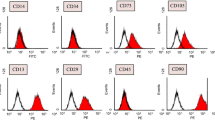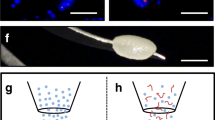Abstract
Regenerative medicine via its application in soft tissue reconstruction through novel methods in adipose tissue engineering (ATE) has gained remarkable attention and investment despite simultaneous reports on clinical incidence of graft resorption and impaired vascularization. The underlying malaise here once identified may play a critical role in optimizing implant function. Our work attempts to determine the fate of donor cells and the implant in recipient micro environment using adipose-derived mesenchymal stem cells (ASCs) on a type I collagen sponge, an established scaffold for ATE. Cell components within the construct were identified 21 days post implantation to delineate cell survival, proliferation & terminal roles in vivo. ASC’s are multipotent, while collagen type I is a natural extra cellular matrix component. Commercially available bovine type I collagen was characterized for its physiochemical properties and cyto-compatibility. Nile red staining of induced ASCs identified red globular structures in cell cytoplasm indicating oil droplet accumulation. Similarly, in vivo implantation of the cell seeded collagen construct in rat model for 21 days in the dorsal muscle, showed genesis of chicken wire network of fat-like cells, which was demonstrated histologically using a variety of staining techniques. Furthermore, fluorescent in situ hybridization (FISH) technique established the efficiency of transplantation wherein the male donor cells with labeled Y chromosome was identified 21 days post implantation from female rat model. Retrieved samples at 21 days indicated adipogenesis in situ, with donor cells highlighted via FISH. The study provides an insight to stem cells in ATE from genesis to functionalization.








Similar content being viewed by others
References
American Society of Plastic Surgeons. American Society of Plastic Surgeons Report of the 2010 Plastic Surgery Statistics [Internet]. 2010. http://www.plasticsurgery.org/Documents/news-resources/statistics/2010-statisticss/Top-Level/2010-US-cosmetic-reconstructive-plastic-surgery-minimally-invasive-statistics2.pdf.
Chourmouzi D, Vryzas T, Drevelegas A. New spontaneous breast seroma 5 years after augmentation: a case report. Cases J. 2009;2:7126
Gimble JM, Katz AJ, Bunnell BA. Adipose-derived stem cells for regenerative medicine. Circ Res. 2007;100(9):1249–60.
Hum Zuk PA, Zhu M, Ashjian P, De Ugarte DA, Huang JI, Mizuno H, Alfonso ZC, Fraser JK, Benhaim P, Hedrick MH. Human adipose tissue is a source of multipotent stem cells. Mol Biol Cell. 2002;13(12):4279–95.
Patrick CW Jr, Chauvin PB, Hobley J, Reece GP. Preadipocyte seeded PLGA scaffolds for adipose tissue engineering. Tissue Eng. 1999;5(2):139–51.
Schäffler A, Büchler C. Concise review: adipose tissue-derived stromal cells—basic and clinical implications for novel cell-based therapies. Stem Cells. 2007;25(4):818–27.
Xu M, Yan Y, Liu H, Yao R, Wang X. Controlled adipose-derived stromal cells differentiation into adipose and endothelial cells in a 3D structure established by cell-assembly technique. J Bioact Compat Polym. 2009;24(1):31–47.
Niemela S, Miettinen S, Sarkanen JR, Ashammakhi N. Adipose tissue and adipocyte differentiation: molecular and cellular aspects and tissue engineering applications. In: Ashammakhi N, Reis R, Chiellini F, editors. Topics in tissue engineering. Biomaterials and Tissue Engineering Group; Chapter 4, 2008; 1–26.
Flynn L, Prestwich GD, Semple JL, Woodhouse KA. Adipose tissue engineering with naturally derived scaffolds and adipose-derived stem cells. Biomaterials. 2007;28(26):3834–42.
Glowacki J, Mizuno S. Collagen scaffolds for tissue engineering. Biopolymers. 2008;89(5):338–44.
Kimura Y, Ozeki M, Inamoto T, Tabata Y. Adipose tissue engineering based on human preadipocytes combined with gelatin microspheres containing basic fibroblast growth factor. Biomaterials. 2003;24(14):2513–21.
von Heimburg D, Zachariah S, Heschel I, Kühling H, Schoof H, Hafemann B, Pallua N. Human preadipocytes seeded on freeze-dried collagen scaffolds investigated in vitro and in vivo. Biomaterials. 2001;22(5):429–38.
Wu X, Black L, Santacana-Laffitte G, Patrick CW Jr. Preparation and assessment of glutaraldehyde-crosslinked collagen-chitosan hydrogels for adipose tissue engineering. J Biomed Mater Res A. 2007;81(1):59–65.
Patrick CW Jr. Tissue engineering strategies for adipose tissue repair. Anat Rec. 2001;263(4):361–6.
Patrick CW. Breast tissue engineering. Annu Rev Biomed Eng. 2004;6:109–130.
Ahmed F, Wyckoff J, Lin EY, Wang W, Wang Y, Hennighausen L, Miyazaki J, Jones J, Pollard JW, Condeelis JS, Segall JE. GFP expression in the mammary gland for imaging of mammary tumor cells in transgenic mice. Cancer Res. 2002;62(24):7166–9.
Progatzky F, Dallman MJ, Lo Celso C. From seeing to believing: labelling strategies for in vivo cell-tracking experiments. Interface Focus. 2013. doi:10.1098/rsfs.2013.0001
Lee JM, Kim BS, Lee H, Im GI. In vivo tracking of mesenchymal stem cells using fluorescent nanoparticles in an osteochondral repair model. Mol Ther. 2012;20(7):1434–42.
Ahrens ET, Bulte JW. Tracking immune cells in vivo using magnetic resonance imaging. Nat Rev Immunol. 2013;13(10):755–63.
Azene N, Fu Y, Kraitchman DL. Tracking of stem cells in vivo for cardiovascular applications. J Cardiovasc Reson. 2009;16:7 doi:10.1186/1532-429X-16-7
Nair MB, Varma HK, John A. Triphasic ceramic coated hydroxyapatite as a niche for goat stem cell-derived osteoblasts for bone regeneration and repair. J Mater Sci Mater Med. 2009;20(1):S251–8.
Livak KJ, Schmittgen TD. Analysis of relative gene expression data using real-time quantitative PCR and the 2(-Delta Delta C(T)) method. Methods. 2001;25(4):402–8.
Guan H, Arany E, van Beek JP, Chamson-Reig A, Thyssen S, Hill DJ, Yang K. Adipose tissue gene expression profiling reveals distinct molecular pathways that define visceral adiposity in offspring of maternal protein restricted rats. Am J Physiol Endocrinol Metab. 2005;288(4):E663–73.
Poulsom R, Forbes SJ, Hodivala-Dilke K, Ryan E, Wyles S, Navaratnarasah S, Jeffery R, Hunt T, Alison M, Cook T, Pusey C, Wright NA. Bone marrow contributes to renal parenchymal turnover and regeneration. J Pathol. 2001;195(2):229–35.
Evans CH, Liu FJ, Glatt V, Hoyland JA, Kirker-Head C, Walsh A, Betz O, Wells JW, Betz V, Porter RM, Saad FA, Gerstenfeld LC, Einhorn TA, Harris MB, Vrahas MS. Use of genetically modified muscle and fat grafts to repair defects in bone and cartilage. Eur Cell Mater. 2009;18:96–111.
Rameshwar P. Microenvironment at tissue injury, a key focus for efficient stem cell therapy: A discussion of mesenchymal stem cells. World J Stem Cells. 2009;1(1):3–7.
Nimni ME, Cheung D, Strates B. Chemically modified collagen: a natural biomaterial for tissue replacement. J Biomed Mater Res. 1987;21(6):741–71.
Knight CG, Morton LF, Peachey AR, Tuckwell DS, Farndale RW, Barnes MJ. The collagen-binding a-domains of integrins alpha(1)beta(1) and alpha(2)beta(1) recognize the same specific amino acid sequence, GFOGER, in native (triple-helical) collagens. J Biol Chem. 2000;275(1):35–40.
John A, Ikada Y, Tabata Y. Tissue engineering bone and adipose tissue – An in vitro study. Trends Biomater Artif Organs. 2002;16(1):28–33.
Jokinen J, Dadu E, Nykvist P, Käpylä J, White DJ, Ivaska J, Vehviläinen P, Reunanen H, Larjava H, Häkkinen L, Heino J. Integrin-mediated cell adhesion to type I collagen fibrils. J Biol Chem. 2004;279(30):31956–63.
Parenteau-Bareil R, Gauvin R, Berthod F. Collagen-based biomaterials for tissue engineering applications. Mater. 2010;3:1863–87.
Kimura Y, Inamoto T, Tabata Y. Adipose tissue formation in collagen scaffolds with different biodegradabilities. J Biomater Sci Polym. 2010;21(4):463–76.
Mauney JR, Nguyen T, Gillen K, Kirker-Head C, Gimble JM, Kaplan DL. Engineering adipose-like tissue in vitro and in vivo utilizing human bone marrow and adipose-derived mesenchymal stem cells with silk fibroin 3D scaffolds. Biomaterials. 2007;28(35):5280–90.
Gomillion CT, Burg KJL. Stem cells and adipose tissue engineering. Biomaterials. 2006;27(36):6052–63.
Ailhaud G, Grimaldi P, Négrel R. Cellular and molecular aspects of adipose tissue development. Annu Rev Nutr. 1992;12:207–33.
Katz AJ, Llull R, Hedrick MH, Futrell JW. Emerging approaches to the tissue engineering of fat. Clin Plast Surg. 1999;26(4):587–603.
DeLany JP, Floyd ZE, Zvonic S, Smith A, Gravois A, Reiners E, Wu X, Kilroy G, Lefevre M, Gimble JM. Proteomic analysis of primary cultures of human adipose-derived stem cells: modulation by adipogenesis. Mol Cell Proteom. 2005;4(6):731–40.
Napolitano LM. Observations on the fine structure of adipose cells. Ann N Y Acad Sci. 1965;131(1):34–42.
Rich L, Whittaker P. Collagen and picrosirius red staining: a polarized light assessment of fibrillar hue and spatial distribution. Braz J Morphol Sci. 2005;22(2):97–104.
Jing W, Lin Y, Wu L, Li X, Nie X, Liu L, Tang W, Zheng X, Tian W. Ectopic adipogenesis of preconditioned adipose-derived stromal cells in an alginate system. Cell Tissue Res. 2007;330(3):567–72.
Frye CA, Wu X, Patrick CW. Microvascular endothelial cells sustain preadipocyte viability under hypoxic conditions. In Vitro Cell Dev Biol Anim. 2005;41(5-6):160–4.
Rehman J, Traktuev D, Li J, Merfeld-Clauss S, Temm-Grove CJ, Bovenkerk JE, Pell CL, Johnstone BH, Considine RV, March KL. Secretion of angiogenic and antiapoptotic factors by human adipose stromal cells. Circulation. 2004;109(10):1292–8.
Planat-Benard V, Silvestre JS, Cousin B, André M, Nibbelink M, Tamarat R, Clergue M, Manneville C, Saillan-Barreau C, Duriez M, Tedgui A, Levy B, Pénicaud L, Casteilla L. Plasticity of human adipose lineage cells toward endothelial cells: physiological and therapeutic perspectives. Circulation. 2004;109(5):656–63.
Venugopal B, Fernandez FB, Babu SS, Harikrishnan VS, Varma H, John A. Adipogenesis on biphasic calcium phosphate using rat adipose-derived mesenchymal stem cells: in vitro and in vivo. J Biomed Mater Res A. 2012;100(6):1427–37.
Acknowledgements
The authors acknowledge the Director SCTIMST, Head, BMT for fund and facilities to carry out the work and for the fellowship for BV. Dr. Anil Kumar TV, Mr. Thulasidharan for cLSM and histology. Dr. HK Varma, Dr. Suresh babu and Mr. Sanoj for SEM and FTIR facilities. There is no conflict of interest raised by the authors.
Author information
Authors and Affiliations
Corresponding author
Ethics declarations
Conflict of interest
The authors declare that they have no competing interests.
Additional information
Conflict of interest
The authors declare that they have no conflict of interest.
Rights and permissions
About this article
Cite this article
Venugopal, B., Fernandez, F., Harikrishnan, V.S. et al. Post implantation fate of adipogenic induced mesenchymal stem cells on Type I collagen scaffold in a rat model. J Mater Sci: Mater Med 28, 28 (2017). https://doi.org/10.1007/s10856-016-5838-7
Received:
Accepted:
Published:
DOI: https://doi.org/10.1007/s10856-016-5838-7




